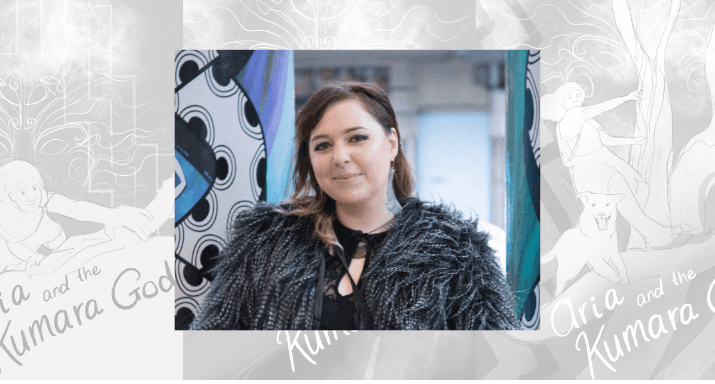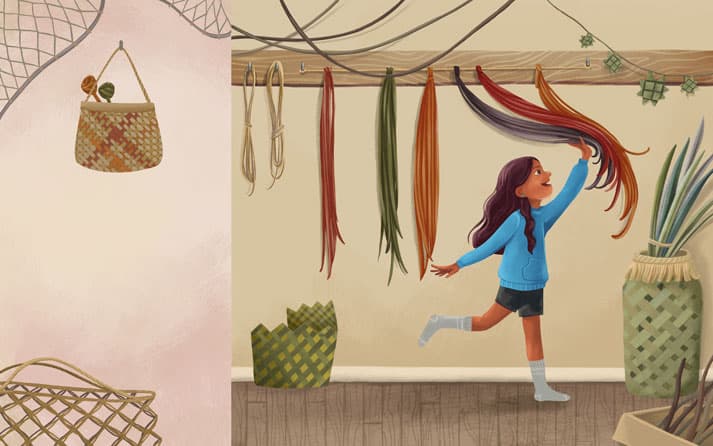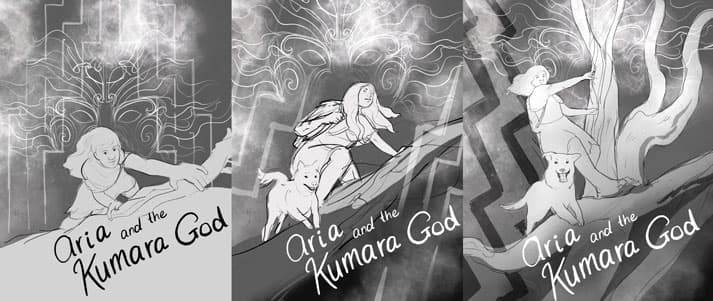Illustrator Isobel Joy Te Aho-White on the power of children's books, and her favourite art mediums

Isobel Joy Te Aho-White (Ngāi Tahu, Ngāti Kahungunu ki te Wairoa), is a freelance illustrator whose work beautifully marries a representational style with layers of symbolism and visual metaphors.
Barbara Uini spoke to Izzy about her mahi, creative journey, sources of inspiration, and recent projects.
Kia ora Izzy. What is it that captivates you about creating illustrations for picture books, and was this always a creative space that you have felt drawn to?
I’ve always had an interest in illustration and storytelling – since I was a kid I would write and illustrate my own stories and get totally immersed in the world-building and details. Picture books were a natural progression of that.
I also do a bit of editorial work and comics, but the format of picture books gives me the most freedom and potential for experimentation. The 32 pages of a children’s book is the perfect length to visually tell a story in a way that keeps my attention but doesn’t burn me out.

You have been a freelance illustrator for more than ten years and have produced some beautiful work. What was it like to take that initial leap of faith to become a freelancer?
Thanks! It was pretty scary! I came fresh out of uni with a graphic design degree and didn’t really have a job lined up, so I pretty much started from scratch. I was on the Jobseeker’s benefit for the first few years to supplement my art income. Some people can work another fulltime job while trying to make a freelancing career work, but that wasn’t the case for me. I was having recurrent panic attacks, which I later learnt was exacerbated by the stress. I was lucky to get support and to have people believe in me, because I really did need a lot of support at first. My whānau and kaumātua wrapped me in aroha and healing. I saw a specialist who diagnosed me with autism, and I had to learn to walk to the beat of my own drum.
Once a week I started to run craft workshops at a local retirement home and the rest of the time was spent making my own zines based around botanical studies of native plants and retelling the pūrākau (ancestral stories) of atua Māori (gods and goddesses) in comic form. I sold these at markets and festivals.
Huia Publishers and Lift Education were the first to commission work from me. A book I illustrated for Huia was in the NZ Children and Young Adult book awards, and from there I was able to get enough work to support myself financially - and that’s where I’m at today.
I think the uncertainty of freelancing is a reason why many people feel that making that leap of faith is so difficult. But there are some for who it seems like the only option!
What are some of the challenges and highlights of collaborating with authors and how closely do you work with the authors of the books you illustrate?
It tends to vary from book to book, and it also depends on the publisher. There are a couple of authors I’ve collaborated with who I am yet to meet in person – it can be difficult if they live on the other side of the country, or in another country. There are other authors who have roped me in very early on in the process before they’ve even submitted their manuscript to a publisher!
Personally, I like to kick off a project with a good chat and if possible, a coffee – but it’s a tikanga that can get lost in the very busy process of publication. I also like to get to know the people behind the scenes of a publishing house - the editors and designers, who are crucial in making the illustrations look their best, and who I work with sometimes on multiple different projects.
Your work spans a variety of media, using digital and traditional mediums. Is there one medium that you feel a special affinity for?
Watercolour or ink wash is my favourite because it’s unpredictable, but at the same time meditative. It’s like doing a dance with water. Cold press paper is a nice tactile experience too. The downside of these mediums is that it can be more time consuming to edit mistakes, which is difficult if I have a job with strict time constraints. I do like to make my own digital brushes and textures out of scanned pieces of paper that I’ve splashed ink and watercolour onto, which gives my illustrations a bit of a mixed media feel. I also like to layer colour pencil over a watercolour wash background to get the detailed edges crisp.
Your illustrations often hold symbolic and metaphorical aspects. Where do you draw your inspiration from when creating layers of meaning in your work?
I’m inspired by ancient pagan artforms and pictograms. One thing that makes Māori design unique is that it is a sophisticated language; a living language that continues to develop in the hands of contemporary ringatoi (Māori artists). The symbols and patterns of whakairo (carving), tā moko (tattoo), and rāranga (weaving), can be understood by how they are placed in relation to each other, and so each pou whakairo (carved post) or tukutuku (woven panel) tells a story. There’s a lot of exciting art experimentation going on in contemporary Māori art, with the symbolism of our traditional art disciplines carrying across into new mediums by contemporary ringatoi.
Personally, I’m inspired by art from both my Pākehā and Māori sides and aim to unify these in my illustrative work to create a representational style interlaced with more abstracted Māori design. I will create the design so that it is reflective of what’s being shown - for example, if I’m illustrating a scene with a waterfall or a gust of wind, I could overlay a pūhoro onto it, which is a symbol that carries the meaning of movement, swiftness, and of ebb and flow. If I’m illustrating a parent caring for a child, I may incorporate the use of a koiri design to show nurturing, or a harakeke design that shows the importance of the family structure. Working this way strengthens the work and affirms the story from two cultural perspectives.

You have recently illustrated two picture books with Matariki themes, including Witi Ihimaera’s Āria and the Kumara God and Ngā Kupenga a Nanny Rina by Qiane Matata-Sipu. Can you tell us a bit about your process when working on these projects?
Ngā Kupenga a Nanny Rina was a challenge because I had a deadline of a few weeks, which is the shortest turnaround for a book that I’ve ever had. I’m stoked that it’s done so well. On reading Qiane’s story I felt instantly connected to it and we really clicked on how to show the characters and environment. Like my own māmā, Nanny Rina is a weaver with pale skin, long silver hair and a gentle, guiding wairua. Haeata te Kapua has the likeness of Qiane’s daughter – high energy, outdoorsy and eager to learn. I love that we both pay homage to our whānau with this pukapuka.
Witi’s book was more labour-intensive because it’s a longer story with a lot of action and world-building, and multiple characters who have grown since the last book (The Astromancer/Te Kōkōrangi). The design of Toi Huarewa, the vine that links the earth and heavens, took a few attempts to get right, and Witi suggested I incorporate a poutama pattern into it. The poutama is a tukutuku pattern that symbolises Tāne’s (in some stories Tāwhaki) journey to the heavens to gain the three kete of knowledge, and more broadly, the quest to seek knowledge. It turned out almost looking like it’s made of bismuth in places, and I really enjoyed drawing the parts that were fragmenting away.
The court of Whānui at the top of the vine is bathed in a golden glow, with the dignitaries from different nations and mythologies gathered, and the poutama appears as a tukutuku on the back wall, where it is often seen in the wharenui of a marae. There was also some inspiration from Dali’s surrealism landscapes in the valley where the vine is anchored, and inspiration from 18th century English fairy books in the scenes with the tūrehu leaping from the trees. That was pure fun. I think that this book was challenging in the sense that I pushed myself to the max of my capabilities with every scene.

What would you say are the most important influences in your illustration work?
Hard to narrow it down because there are so many! Kaitiakitanga and taiao are often at the forefront of my mind - reciprocity and respect for our natural world. I also want my work to encourage people, especially children, to feel comfortable in their skin, like they’re represented in the characters that they see in their media. And if they’re a bit different from their peers, to show them how cool and special they are, and what they’re capable of. Children’s books have such a power and responsibility to do that.
Isobel Joy Te Aho-White (Ngāti Kahungunu, Ngāi Tahu) is an award-winning freelance Illustrator and graphic artist with a passion for kaupapa Māori, environmentalism and children’s books. She has illustrated over 30 books.
Barbara Uini is a teacher, writer and artist living in Tāmaki Makaurau. She enjoys working in a variety of media, and is currently exploring the creative possibilities of combining ink, graphite and cold tea. She has published short stories and illustrations.